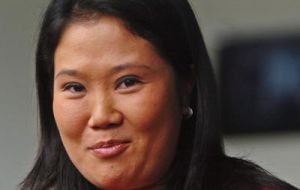MercoPress. South Atlantic News Agency
Humala’s run off with Keiko Fujimori; Peruvian economy faces overheating
 With votes from rural areas and the Andes communities, Keiko Fujimori defeated PPK for the run off
With votes from rural areas and the Andes communities, Keiko Fujimori defeated PPK for the run off Peru’s presidential election on Sunday will have a second round of voting between Ollanta Humala and Keiko Fujimori on 5th June, according to the latest official percentages which indicate the nationalist former Army officer has 31.75% of the vote and the daughter of former president Alberto Fujimori, 23.29%, quite distanced from Pedro Pablo Kuczynski’s (PPK) 18.8%.
While a victory for Ms. Fujimori would perhaps be the most market-friendly outcome, it is also true that comparisons between Humala and Venezuela’s Hugo Chavez are overdone, which anyhow won’t prevent a rollercoaster ride for markets, the coming weeks, says Capital Economics.
Since the election is heading for a second round of voting between Mr. Humala and Ms. Fujimori, an opinion poll conducted by Ipsos Apoyo on 3rd April suggested that such a run-off would be a dead heat in which each candidate would receive 42% of the vote.
That evokes memories of the 2006 ballot when Mr. Humala won the first round of voting, only for the beaten candidates to rally behind Alan Garcia, who subsequently triumphed by 55% to 45%.
The same thing may happen again this time around which, given that Ms. Fujimori is an advocate of free-markets, may be the most market-friendly outcome.
Capital Economics looking at the challenges facing the eventual winner in an upcoming election points out to the need to address head on the threat of overheating.
A large fiscal stimulus in 2009 helped to support the Peruvian economy’s strong, v-shaped, recovery last year. But the stimulus has not been unwound quickly enough and, with the economy now booming, fiscal policy needs to be tightened.
Although Peru ran a small primary budget surplus in 2010, the IMF calculates that, given the sharp rebound in growth and commodity prices, it actually ran a structural deficit of about 1% of GDP.
While we doubt that Mr. Humala will oversee a Venezuelan-style fiscal blow-out as some have claimed, he is less likely to tighten fiscal policy and so there is a greater threat of overheating if he wins.
In the medium-term, the new President needs to take steps to tackle the threat of ‘Dutch disease’. There is a risk that continued pressure on the exchange rate from commodity export revenues and capital inflows will damage the competitiveness of the manufacturing sector.
What’s more, capital and labour may be directed to the resources sector and away from manufacturing, where productivity and employment growth tends to be highest. Further improvements to infrastructure, the labour market and the general business environment are required on this front.
Again, Ms. Fujimori may perhaps be the better bet in this regard, though neither candidate will have the full support of Congress to pass radical reforms, concludes Capital Economics.




Top Comments
Disclaimer & comment rulesCommenting for this story is now closed.
If you have a Facebook account, become a fan and comment on our Facebook Page!